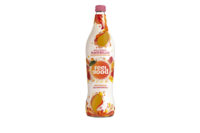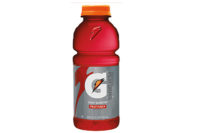U.S. beverage trends expand into Europe
Asian markets interested in functional, health-forward beverages

Hard cider sales in the United Kingdom have been boosted by fruit flavors that give them a “modern edge,” according to Leandro Chiesa, alcohol consultant for IRI. (Image courtesy of Heineken N.V.)

Flavored beers, such as new Cubanisto rum-flavored beer, continue to grow in the United Kingdom, reflecting consumer demand for new and different flavors, according to Anheuser-Busch InBev’s U.K. division. (Image courtesy of AB InBev UK Ltd.)

PepsiCo’s Trop50 stevia-sweetened juice drinks are popular in the United Kingdom, Innova Market Insights’ Lu Ann Williams says. (Image courtesy of PepsiCo Inc.)

Ready-to-drink coffee could experience strong growth in China, Taiwan, Hong Kong and South Korea due to its energy function and appeal with young consumers, Euromonitor International’s Jonas Feliciano says. (Image courtesy of The Coca-Cola Co.)




Liquid concentrates took the U.S. market by storm in 2011 with the launch of Kraft Foods’ Mio liquid water enhancers. In the three years following, major players including The Coca-Cola Co., PepsiCo Inc., Dr Pepper Snapple Group and Nestlé Waters North America entered the new segment. Today, the U.S. market offers more than 30 competing liquid concentrate brands with 150 variants, according to a report by Zenith International Ltd., Bath, U.K. It adds that consumption volume for the segment increased by 85 percent in 2013 to more than 700 million liters, and sales reached $412 million in the United States alone.
Across the pond
Considering the segment’s success in the United States, global market specialists at Zenith note that liquid concentrates could find international success in the United Kingdom, France, Germany, Italy and China, with the United Kingdom leading the pack.
“There is no reason why this should not become a $1 billion international market by 2015, with launches in at least 10 other countries this year,” said Zenith Chairman Richard Hall in a statement. “A year ago, we predicted 50 product variants would be available in Europe by the end of 2014, and that could well be exceeded.”
Early this year, British soft drinks manufacturer Britvic plc launched Robinsons Squash’d liquid concentrates, which are suitable for on-the-go consumption occasions. As a result, the company expects to drive the development of a new “pocket squash” segment in the United Kingdom, which it believes could be worth 200 million pounds over the next five years, it says. “Squash” is a non-alcohol concentrated syrup typically made with fruit juice, water and sugar.
Although the United States might have kicked off a global beverage trend of on-the-go liquid concentrates, the country’s most prominent beverage contribution to the world still is cola, Zenith’s Hall notes. And now, U.S. beverage-makers’ recent activity in the protein drinks segment is impacting other markets, such as the United Kingdom.
In the performance drink category, the United States has led development of ready-to-drink (RTD) beverages with dairy-based protein sources, says Lu Ann Williams, head of research at Innova Market Insights, the Netherlands. As this segment grows in the U.S. market, it also is gaining momentum in other major markets due to consumers’ rising interest in protein content as well as an increase in targeting more specific consumer groups, she adds.
Last month, Benicia, Calif.-based CytoSport launched Muscle Milk Protein RTD beverages in the United Kingdom. A 330-ml bottle contains 20 grams of dairy protein and is suitable for athletes and consumers seeking to lead healthy, active lifestyles, the company says.
Conversely, hard ciders gained popularity in the United Kingdom long before they reached the mainstream U.S. market. And even though they are not new to the U.K. market, hard ciders are continuing their double-digit growth within that region, according to Information Resources Inc. (IRI), Chicago. Recent sales have been boosted by the introduction of new fruit-flavored ciders that give a “modern edge” to the category, says Leandro Chiesa, alcohol consultant for IRI. Amsterdam-based Heineken N.V.’s Bulmer’s Bold Black Cherry and Pressed Red Grape ciders are driving much of this growth, he says. This year, Bulmer’s Fruit Harvest and Indian Summer hard ciders made their debut, which forecasts continued growth in the U.K. hard cider market, he adds.
Consumers in the United Kingdom also are increasingly seeking flavor innovation within beer and spirits, Chiesa says. Anheuser-Busch InBev’s U.K. division recently released Cubanisto rum-flavored beer. The flavored beer category in the United Kingdom was worth 115 million pounds in 2013, according to Nielsen data, and continues to grow both on- and off-premise, reflecting consumer demand for new and different flavors, AB InBev UK Ltd. states.
Similarly, flavored vodkas and gins are evolving in the U.K. market, despite the rarity of flavored whiskeys in the region, IRI’s Chiesa notes. London-based Diageo plc’s Smirnoff brand offers a variety of flavored vodkas in the market. The company also released Gordon’s Crisp Cucumber Gin and Gordon’s Elderflower Gin last year, showcasing flavor innovation, he says.
European generalities
Flavor innovation also is making its way into other European markets. Like the United Kingdom, Greece and France also show an interest in flavored beers, Chiesa says. However, unlike the United Kingdom, the countries both have an increasing demand for flavored whiskeys, such as whiskey with honey, he notes.
Another common trend among European Union nations is the growth of specialty and premium beers as well as new ready-to-serve spirits with low alcohol content, he adds. The trend toward low alcohol content reflects the health consciousness of consumers, he explains.
Recently, beverage-makers in Germany have taken the low-alcohol trend to the next level with a new hybrid beverage called Fassbrause, Chiesa adds.
“This is mostly non-alcoholic beer with lemonade,” he says. “The segment is growing because some big breweries started in the middle of 2012 to enter the market. I don’t think that the segment will have a huge global potential, because it is very specific to the German preference for beer and a trend for refreshing soft drinks for adults, like less-sweet lemonades.”
The most prominent trend in the region, however, came from Greece with wine-based sparkling cocktails like Hugo, which features elderflower syrup, Prosecco wine, and sparkling water, and Spritz, which contains Prosecco wine, bitter liqueur and sparkling water, Chiesa notes. Not surprisingly, Prosecco sparkling wine was the best-performing varietal in Italy, he adds.
On the non-alcohol side of the industry, mineral water performed notably well last year in Germany, the Netherlands and the United Kingdom, says Bjoern Steinbach, non-alcohol drinks consultant for IRI. The category topped soft drinks with 70.6 million euros in value sales in Europe, according to IRI data. Approximately 40 percent of this growth came from Germany, where both still water and sparkling water are growing, he notes.
Mid-calorie markets
Across the globe, interest in healthier beverages continues to top the trends in the non-alcohol segment of the beverage industry, says Jonas Feliciano, beverage analyst for Euromonitor International, Chicago. Carbonated soft drinks and juice drinks have experienced declines in the United States, but this has yet to be reflected in most other markets because they are generally less mature and still growing, Zenith’s Hall says. In particular, zero-calorie sodas have shown a marked decline in the United States, but this has been less pronounced in Western Europe, says Howard Telford, beverages analyst for Euromonitor.
“We’ve seen diets demonstrate some positive growth in Germany and the U.K., albeit from a smaller base, with Coca-Cola Zero a big brand winner since its launch,” he says.
However, mid-calorie carbonated soft drinks offer potential for growth, according to market research firms.
“While an increasing number of soft drink launches are now featuring stevia sweeteners, it has been suggested that they are now targeting the mid-calorie sector by cutting sugar content in half in mainstream soft drinks rather than targeting diet products specifically,” says Innova Market Insights’ Williams.
One of the most significant mid-calorie soft drink launches was The Coca-Cola Co.’s Coca-Cola Life in Argentina, she notes. The beverage launched at retail last summer and features a blend of sugar and stevia with just more than 100 calories in a 600-ml bottle. Purchase, N.Y.-based PepsiCo Inc. also offers a stevia-sweetened version of its Pepsi Next soda in Australia.
“Coke and Pepsi have been using stevia in drinks for some years, but mainly in still fruit drinks,” Williams says. “It has relatively recently been introduced in [Coca-Cola] drinks, such as Vitaminwater Zero and Fanta Select, but not until now in its flagship cola brand.”
In France and the United Kingdom, Sprite was reformulated as a mid-calorie soda using stevia. The U.K. retailer Tesco also introduced its first stevia-sweetened private-label cola recently, Euromonitor’s Telford notes.
“Private-label drinks are a much bigger part of the European retailing experience,” he says. “But these private-label brands will also be forced to innovate to adapt to consumer preferences for health and wellness products.”
The mid-calorie trend also has expanded to include juices. PepsiCo’s Trop50 stevia-sweetened juice drinks are popular in the United Kingdom, Innova Market Insights’ Williams says. The beverages launched in early 2013 and reached sales of 15 million pounds by October 2013, she notes.
Crossing the Pacific
Although much of the health and wellness focus has surrounded the North American and Western European markets, consumers in emerging markets like Latin America and Asia Pacific also are highly conscious of the sugar and calories they consume, Euromonitor’s Feliciano notes.
“While carbonates reign supreme in Latin America, flavored waters are becoming more and more popular as they are thought of as healthier, leaving carbonate manufacturers scrambling to find a diet soda that resonates with consumers,” he adds. “Coca-Cola’s success or failure with Coca-Cola Life is an important consideration.”
Likewise, bottled waters will play an important role in Asia Pacific, Zenith’s Hall notes. Globally, bottled water is expected to increase nearly 100 billion liters from 2013 to 2018 to reach 382 billion liters, according to a 57-country analysis for globaldrinks.com. The majority of this growth will come from Asia, which is forecast to increase from having a 19 percent share of the category to accounting for 48 percent of the category, he reports. The region also is expected to lead growth of fruit juices and nectars in the next five years, he notes.
Adding to the trend of health and wellness, consumers in Asia also seek function, Euromonitor’s Feliciano says.
“The long tradition of homeopathic remedies in Chinese culture has created a consumer base more accepting of functional beverages,” he wrote in a March 30 blog post. “Herbal teas that can help digestion or remove heat from the body have long been popular. Asian specialty drinks such as peanut milk and almond juice are also popular due to a belief that vegetable protein from the beverages can prevent obesity.”
This has resulted in a significant opportunity for new functional and health-focused beverages in the region, Feliciano notes. Beverage brands can best take advantage of this opportunity by merging functionality with targeted marketing, he adds. By following this strategy, Red Bull GmbH’s Red Bull energy drink, Hebei Yangyuan Zhihui Beverage Co. Ltd.’s Yangyuan walnut milk, and Danone’s Mizone functional water each experienced triple-digit dollar sales growth from 2010 to 2013 in off-premise outlets in China, according to Euromonitor data. In particular, Red Bull offers an energy function and targets younger consumers through sponsorships of global sports and youth-oriented activities.
“Marketing to youth consumers continues to be an important way to attract consumers,” Feliciano says. “Sponsorship of sporting events on both a global and regional level is also very important in attracting youth consumers.”
RTD coffee also could capitalize on this strategy because of its energy function and appeal with young consumers, he notes. Therefore, the segment could experience strong growth in China, Taiwan, Hong Kong and South Korea, he adds. Additionally, this strategy will become important for beverage-makers in the growing markets of Brazil, Russia, Indonesia and India, Feliciano wrote in his blog post.
When it comes to alcohol in the Asia Pacific region, China recently emerged as the largest red wine market in the world, according to a joint report by Vinexpo and The International Wine and Spirits Research (IWSR). Consuming more than 155 million 9-liter cases of red wine in 2013, China now is ahead of France and Italy as the No. 1 red-wine-consuming nation. This growth can be attributed to the health benefits of red wine as well as the symbolism of the color red in Chinese culture. In China, red represents good fortune, strength and luck, the report notes.
Similarly, Vinexpo expects both red and white wines to grow in India in the coming years. Both segments are projected to increase by 71 percent in the next five years, it says.
Looking for a reprint of this article?
From high-res PDFs to custom plaques, order your copy today!










